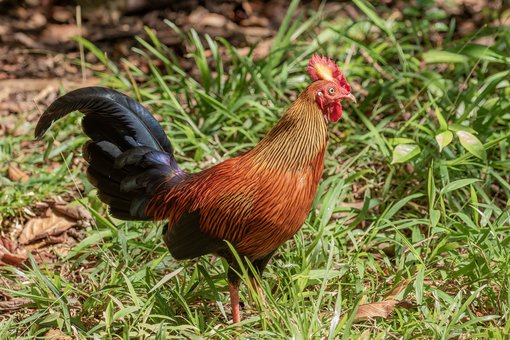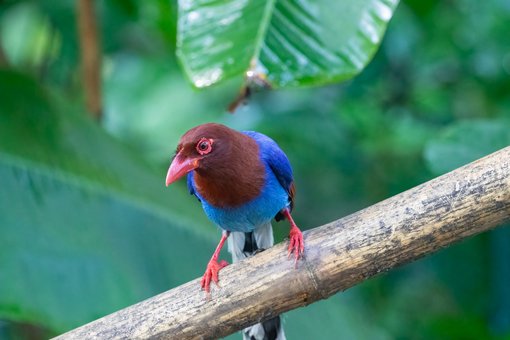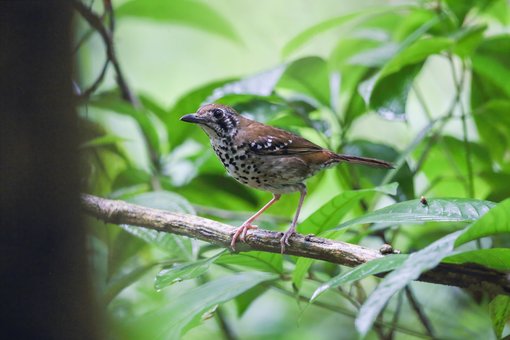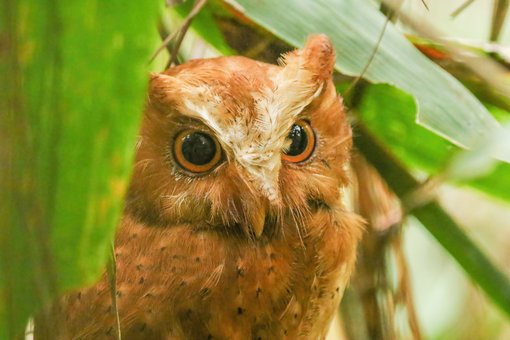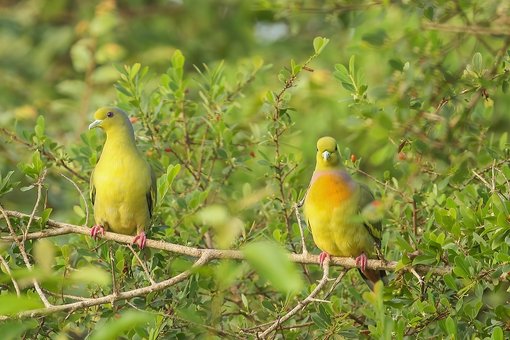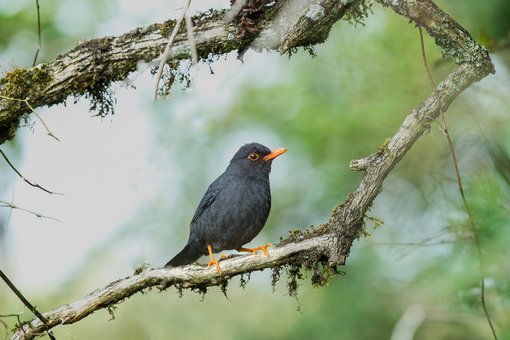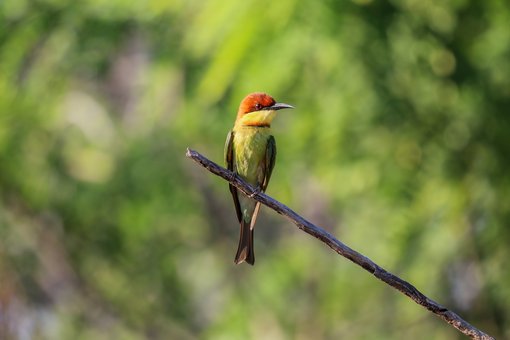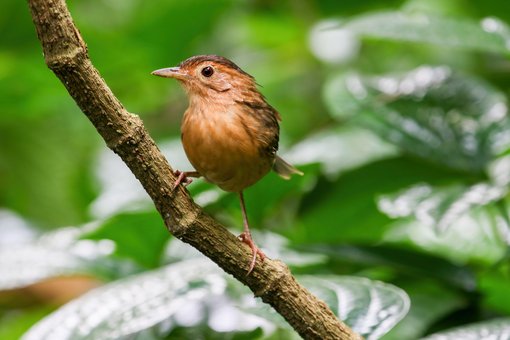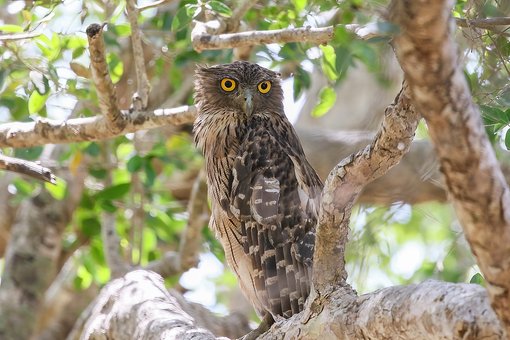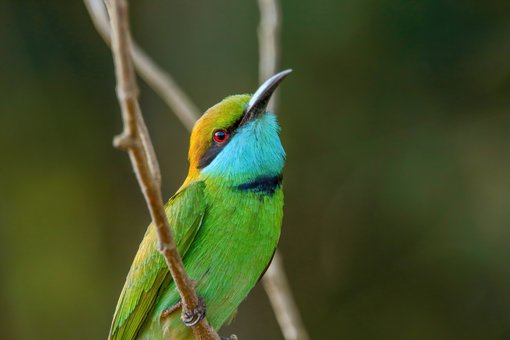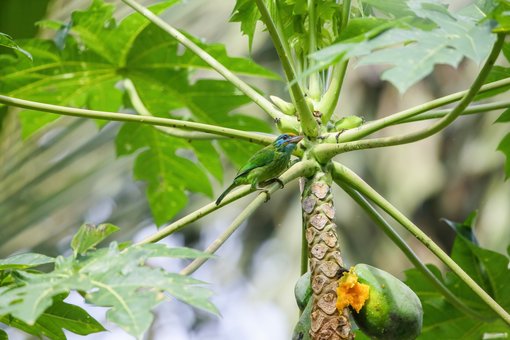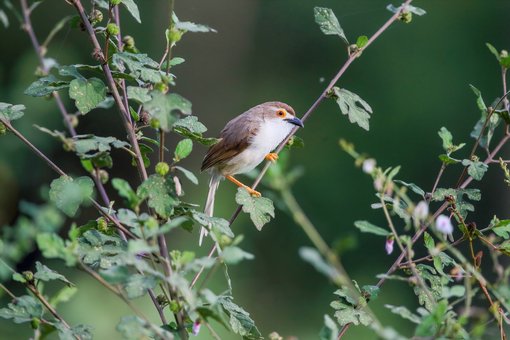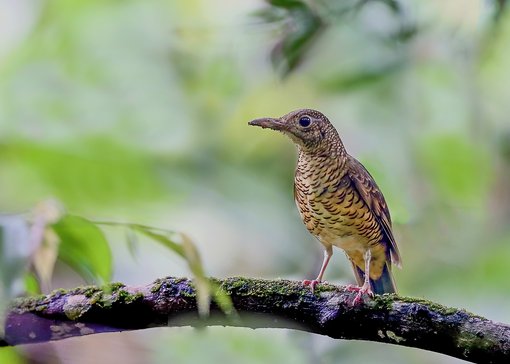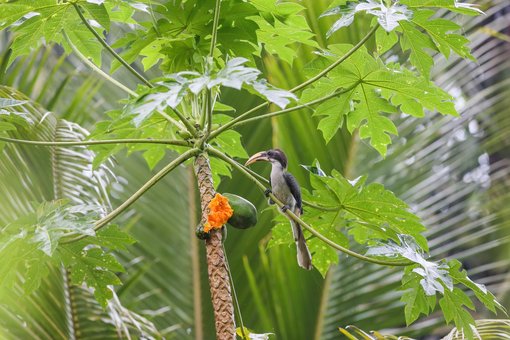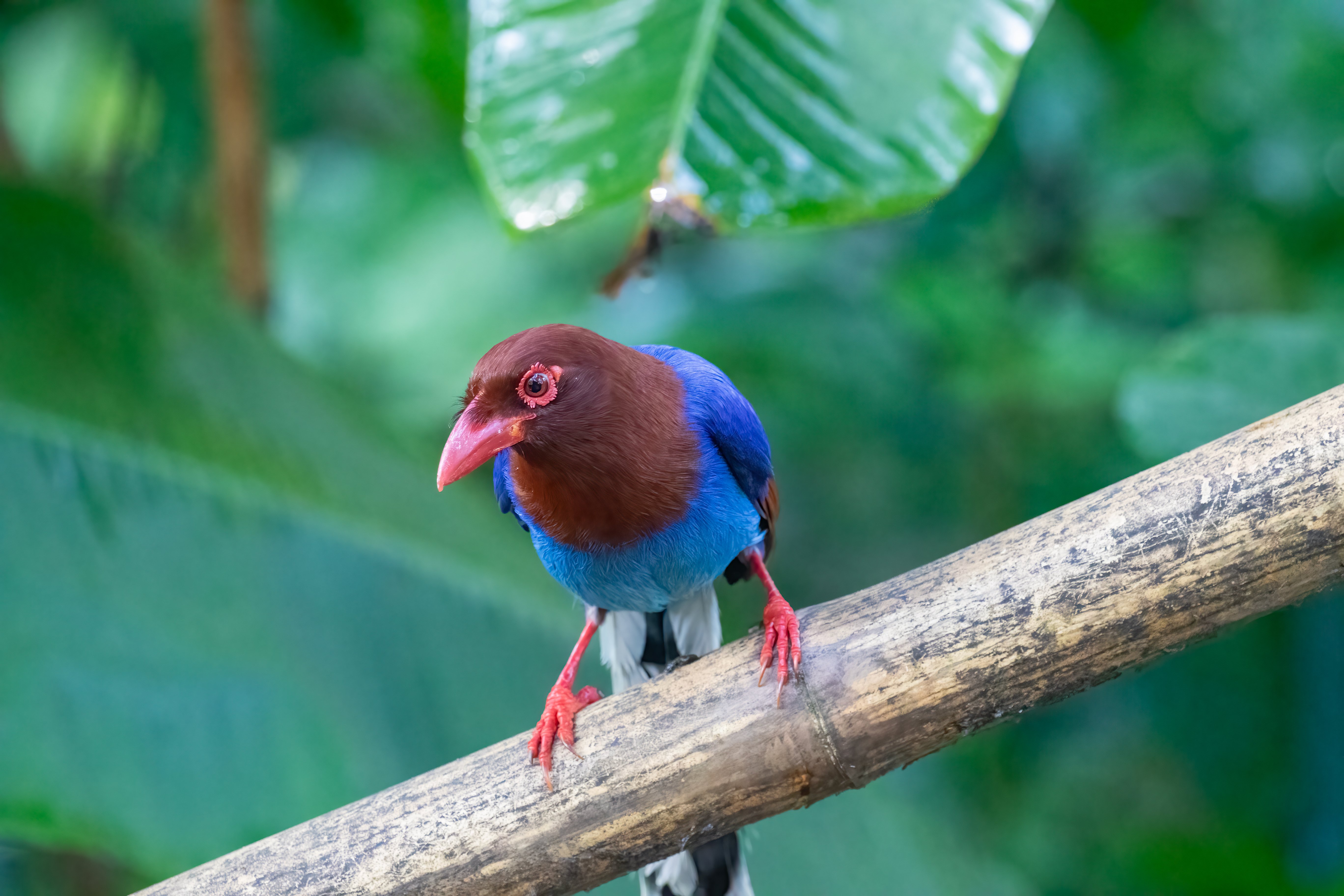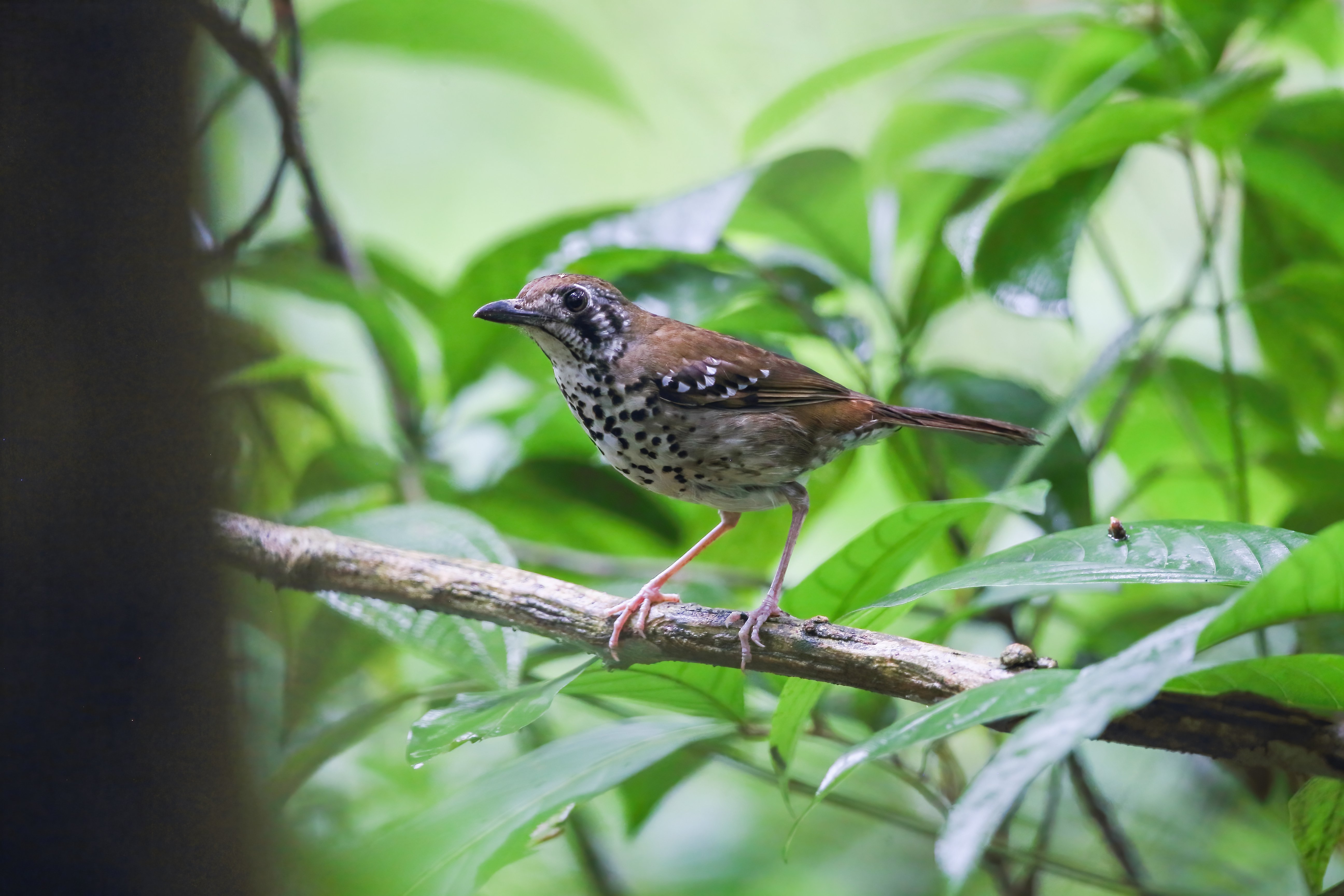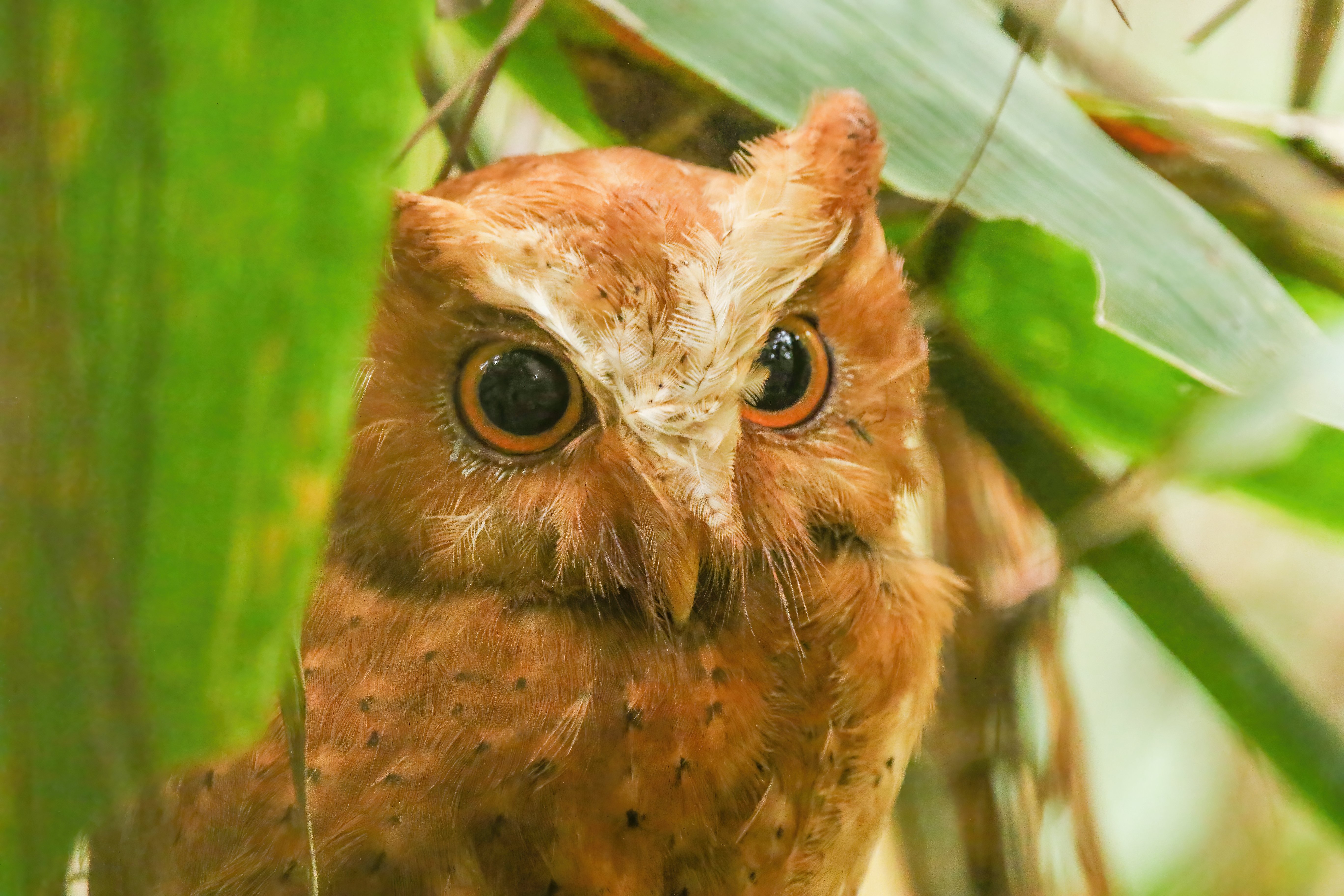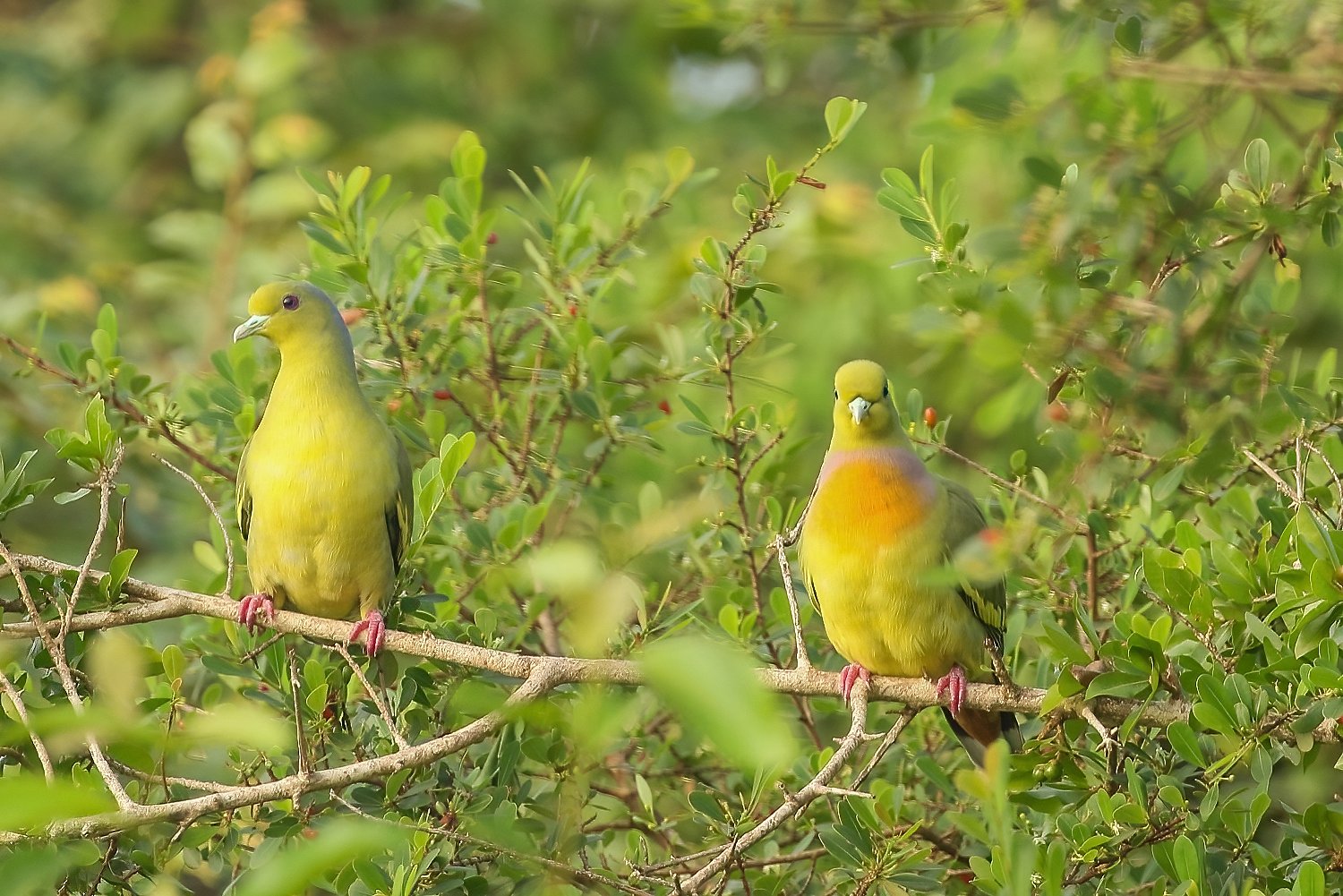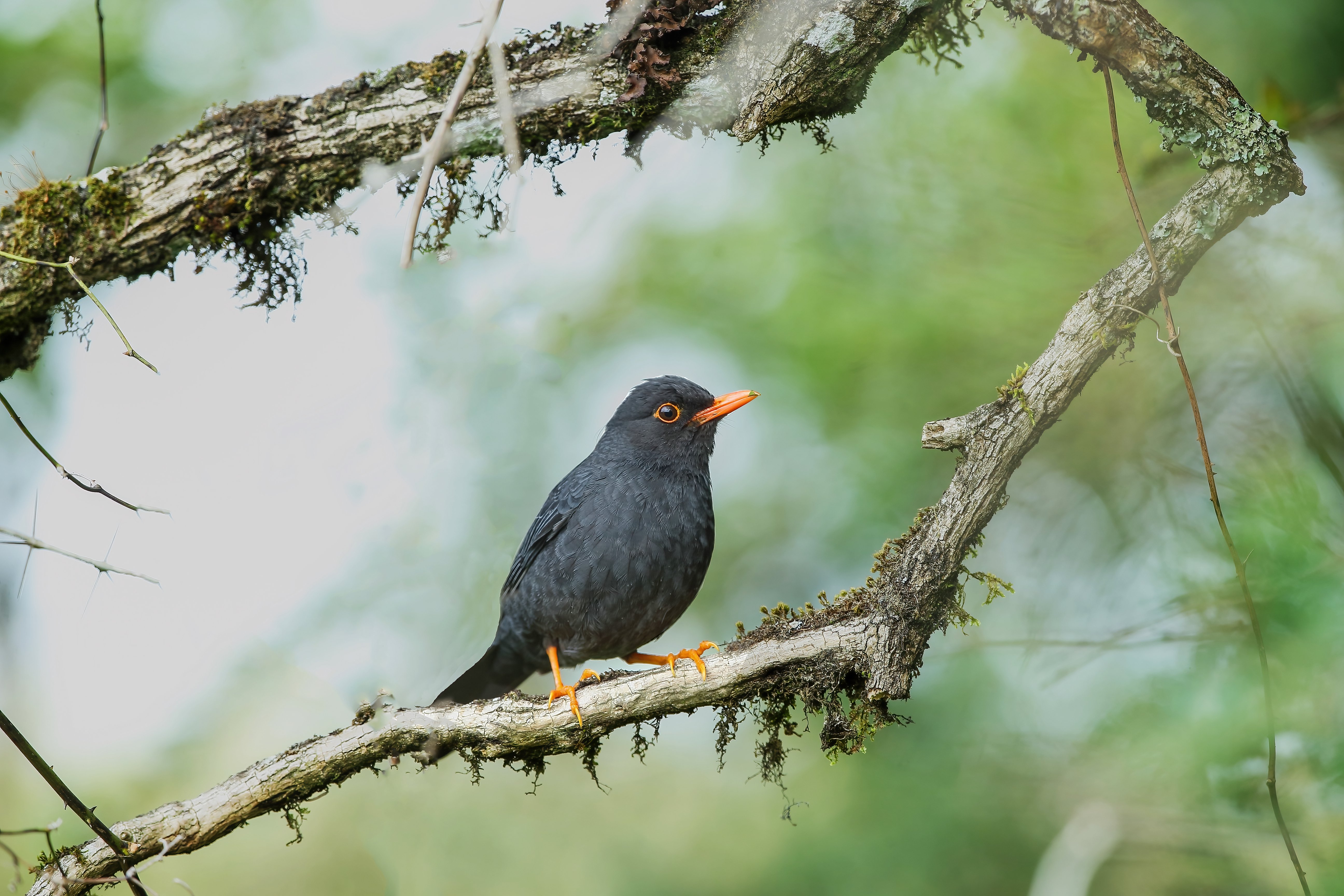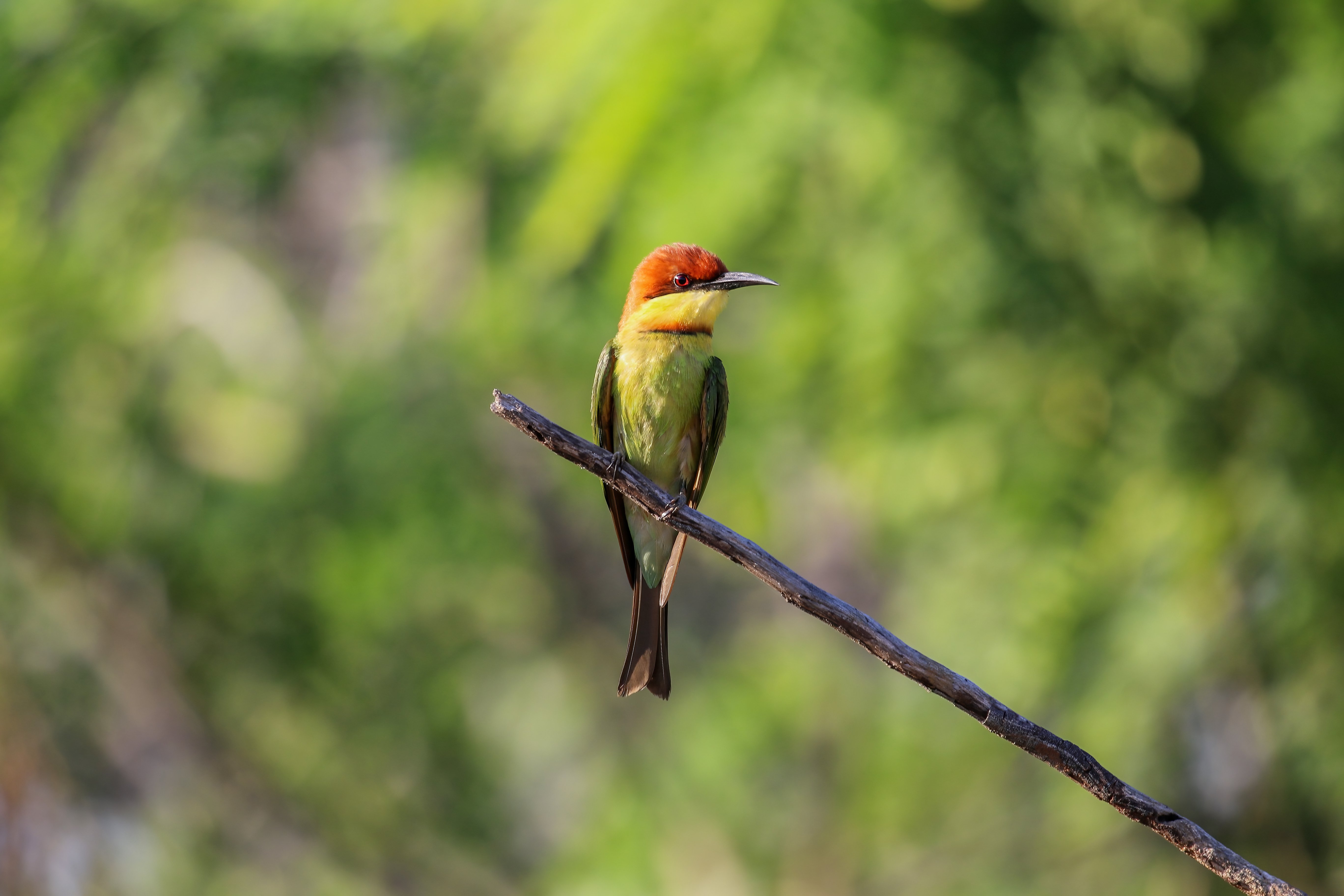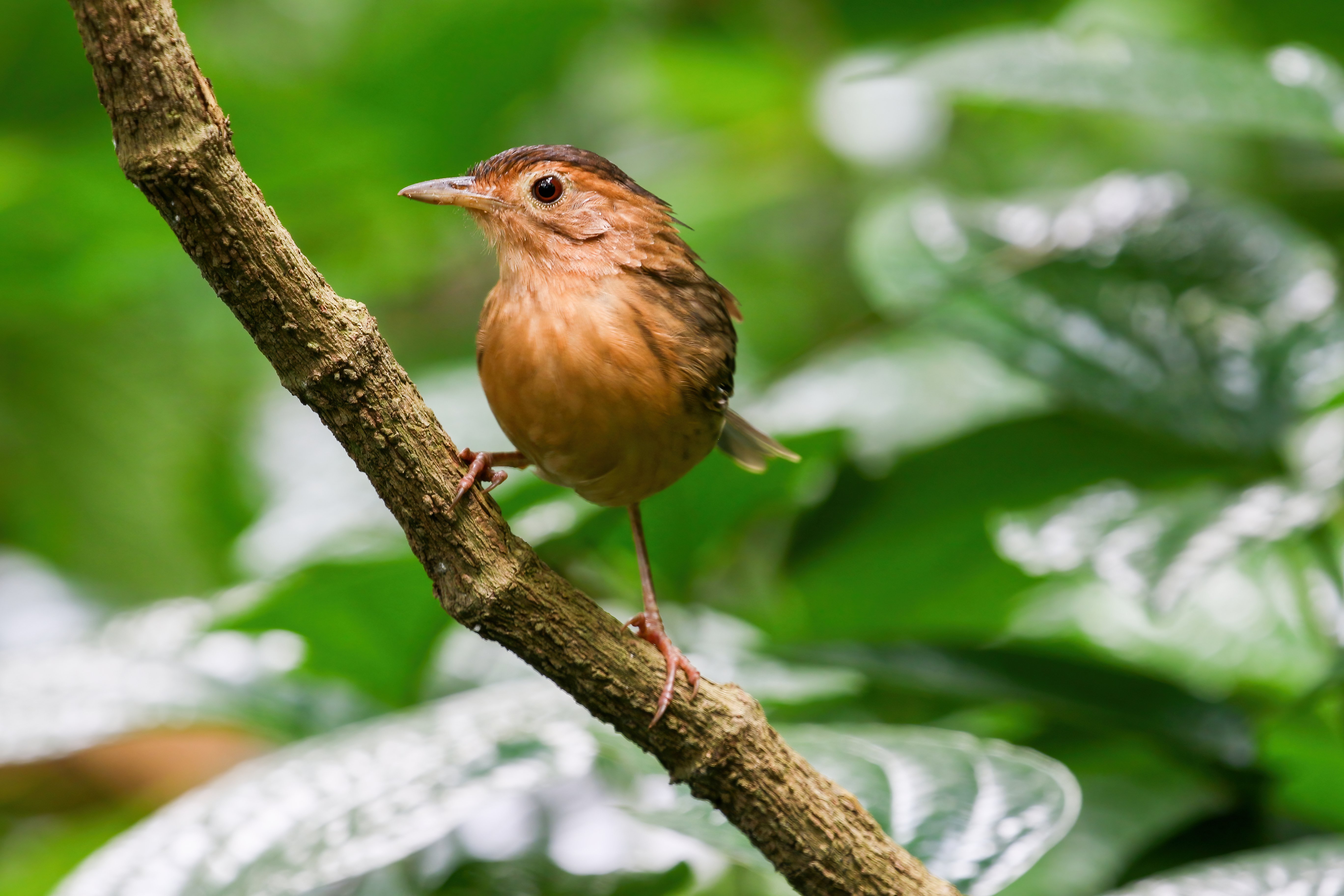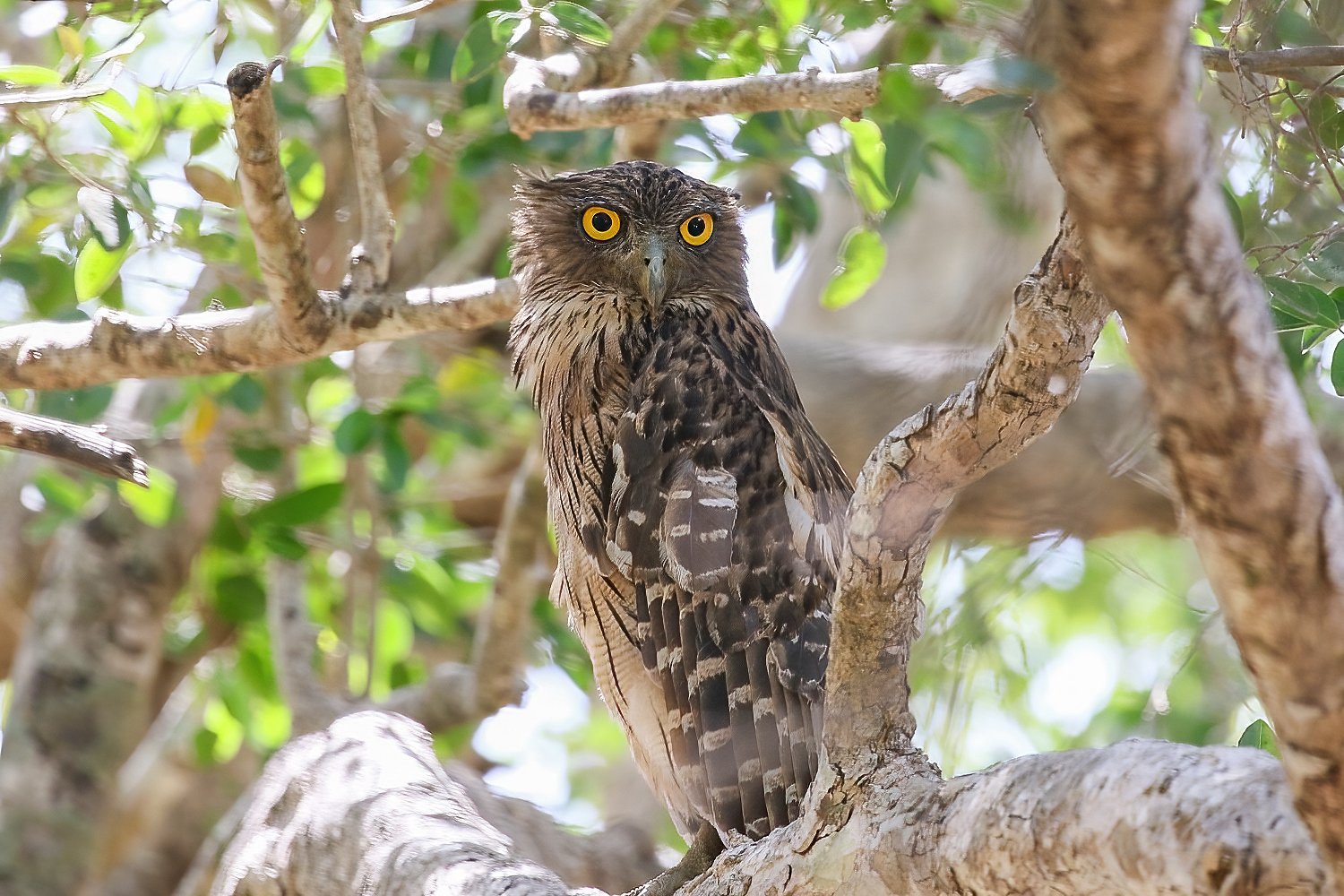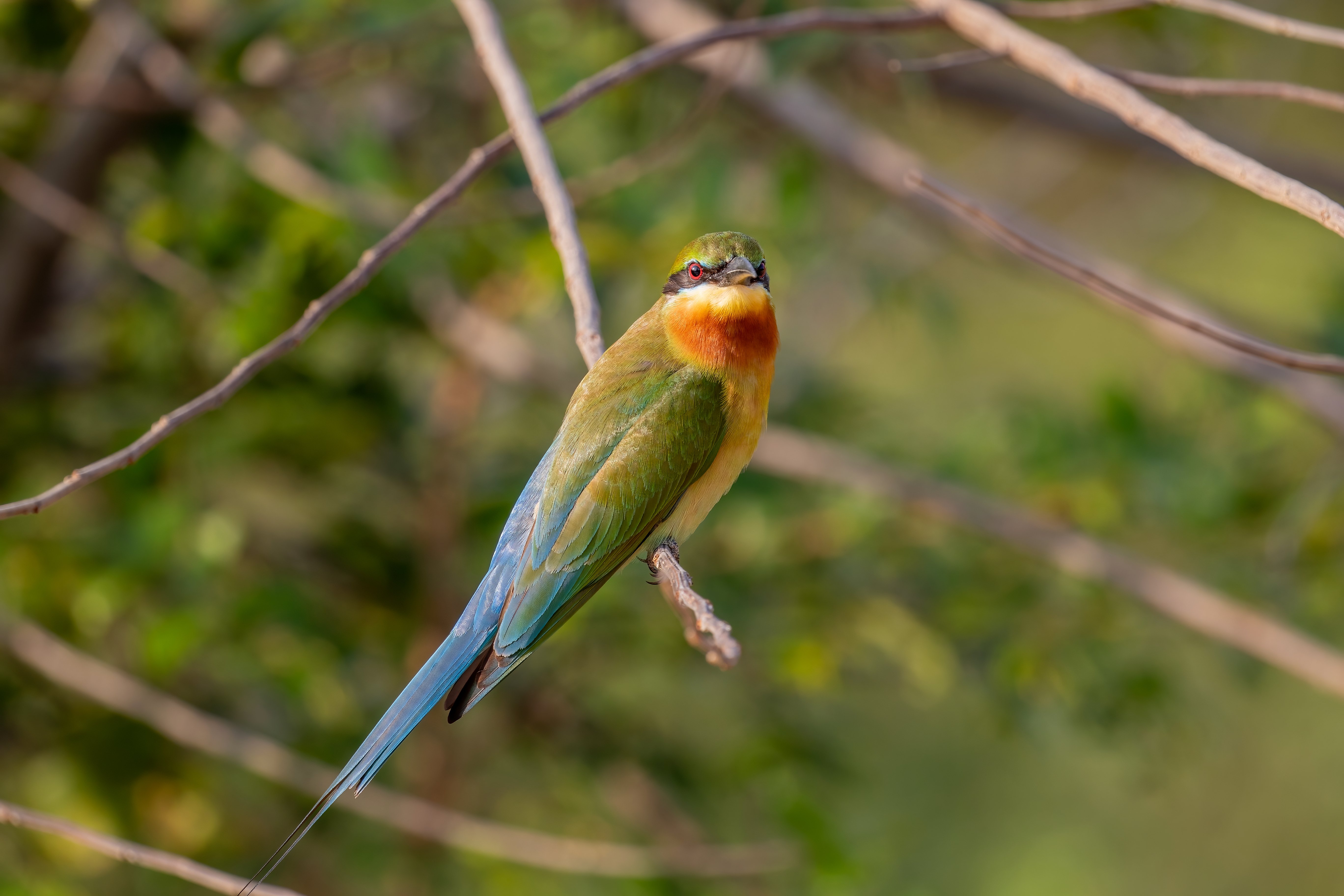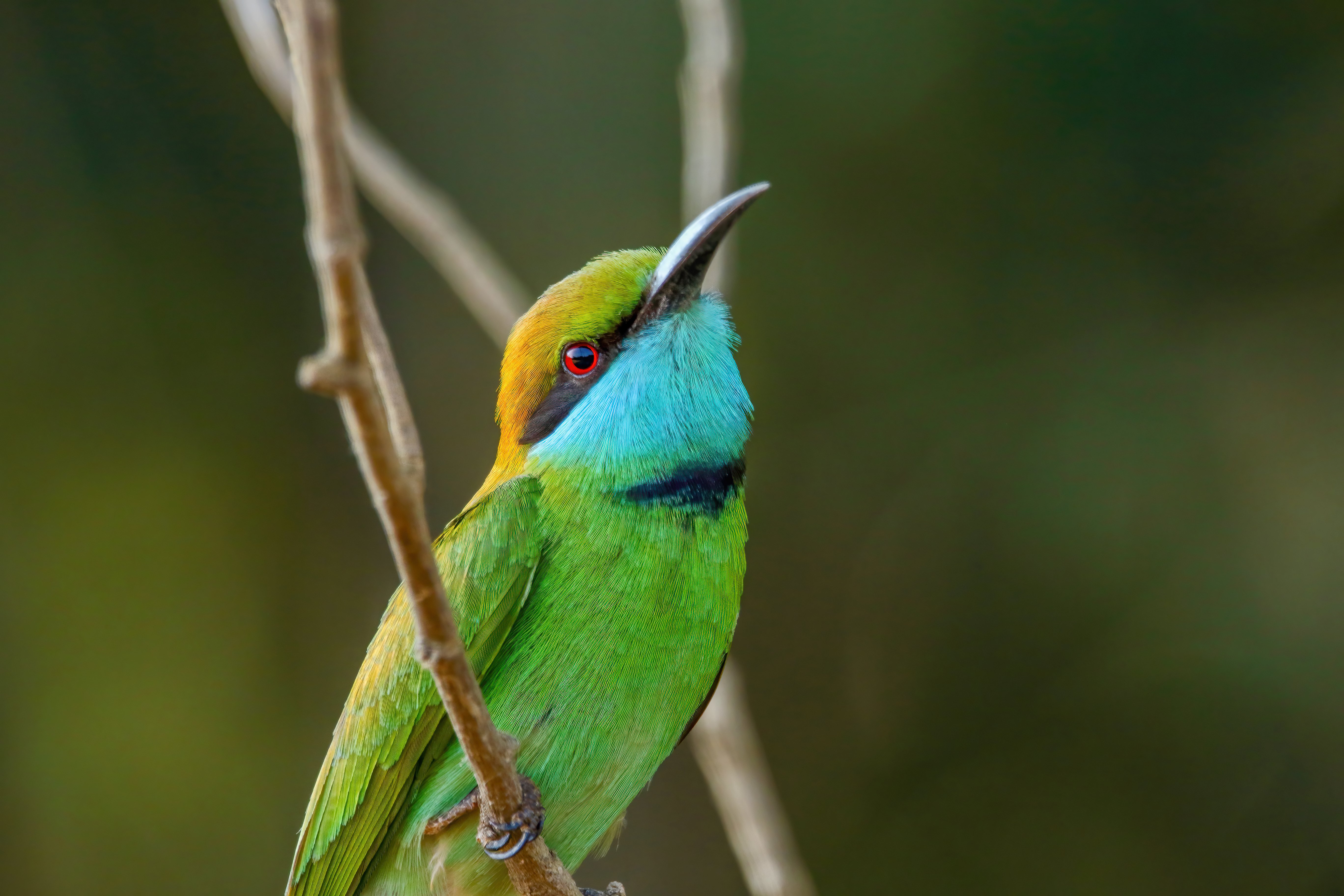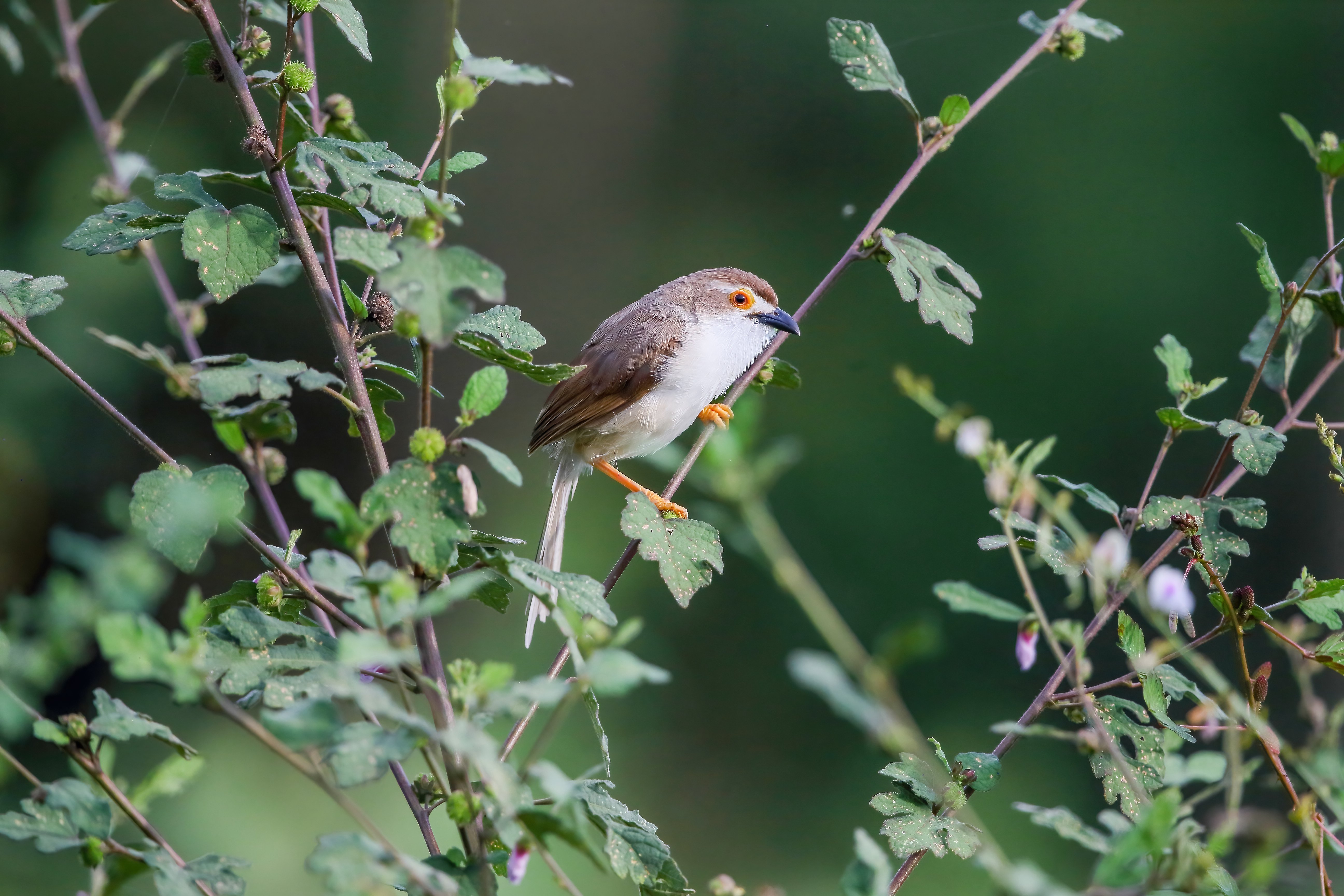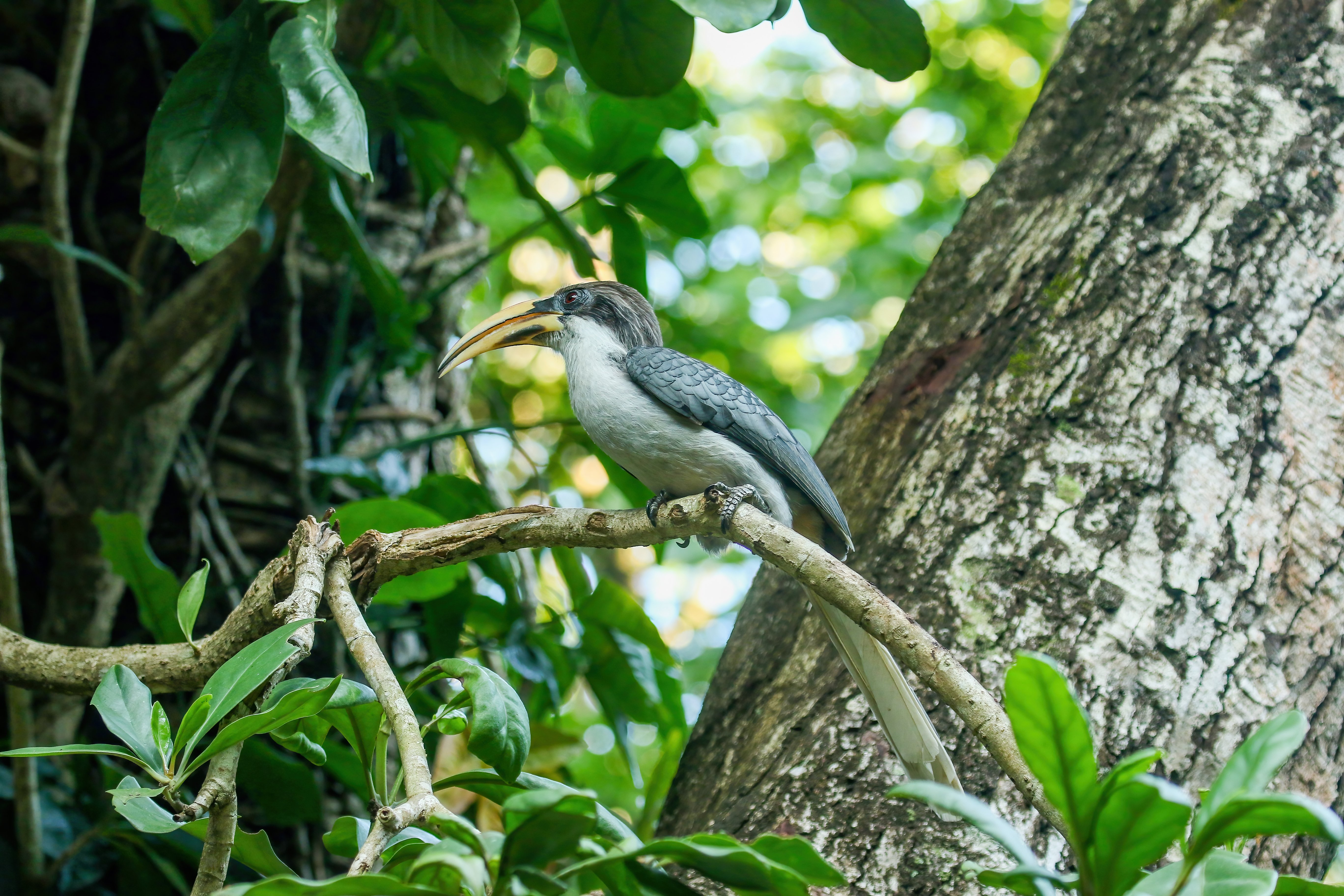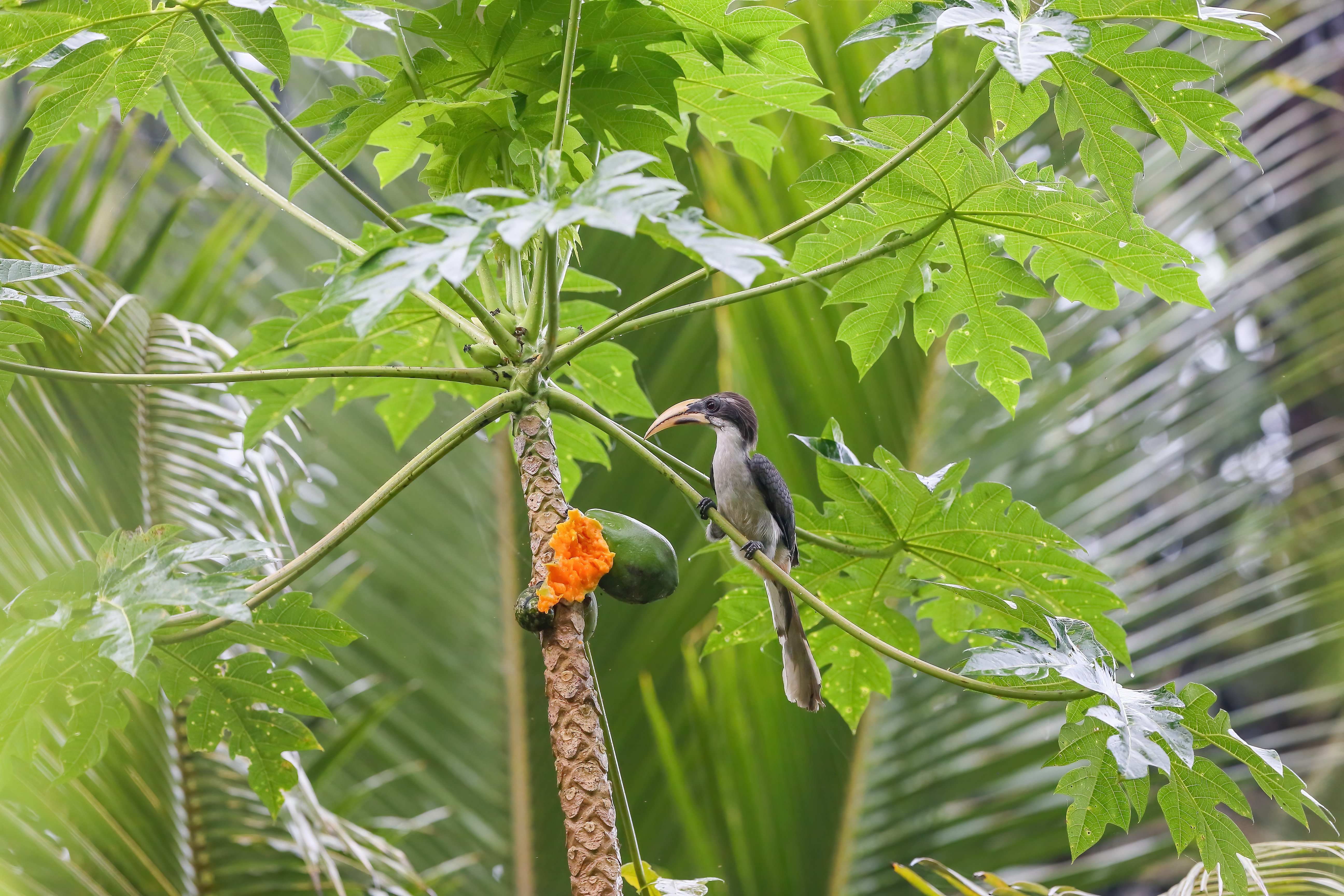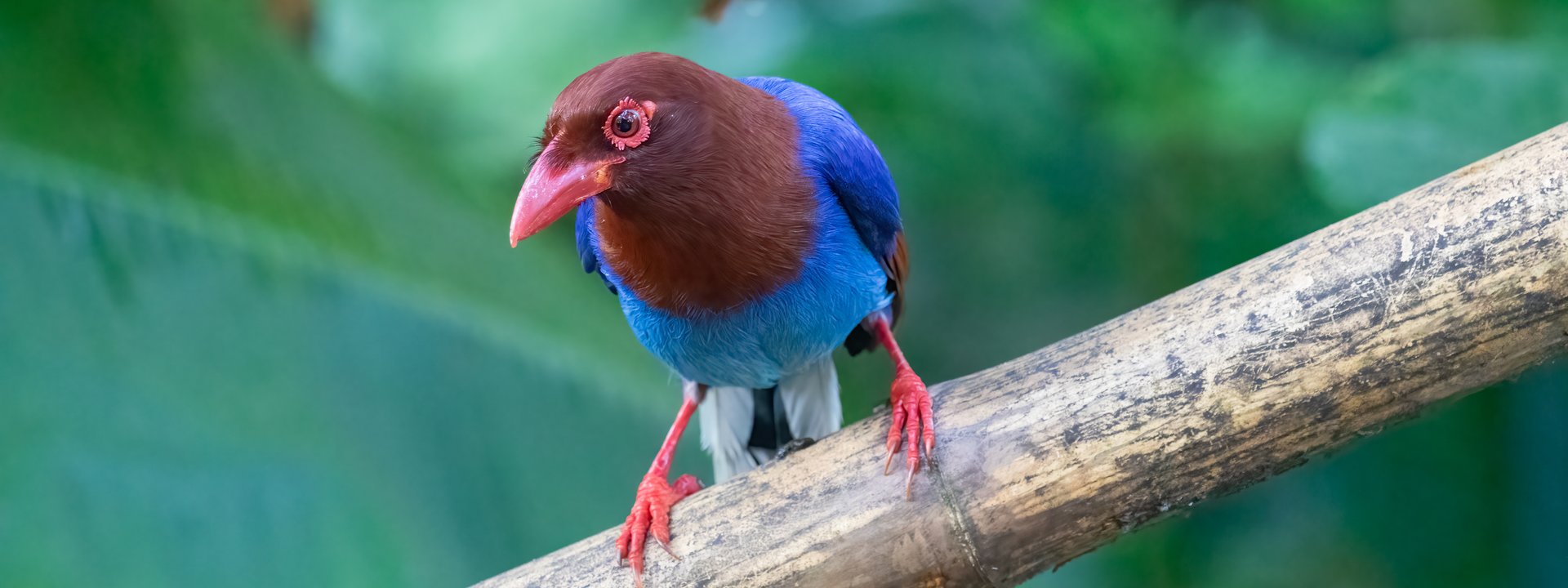Sri Lanka
Jewel of the Indian Ocean
A 13-day, small group birdwatching tour to Sri Lanka targetting all this delightful island's endemic birds with an opportunity to join a whale-watching extension where we hope to see Blue Whales
Limosa’s birdwatching tour to tropical Sri Lanka features a meticulously planned itinerary. We have a decent chance of seeing all of the island’s endemic birds including Sri Lanka Junglefowl, Sri Lanka Hanging Parrot, Sri Lanka Blue Magpie and Serendib Scops Owl, a species which was only discovered in 2001.
There will also be a host of Southern India specialities and winter visitors present at the time of our tour with possibilities such as Malabar Trogon, Indian Pitta and Sri Lanka Frogmouth.
In addition, we hope to see some special mammals, including Asian Elephant and Leopard, as well as a range of colourful butterflies and dragonflies. There is also an extension which provides the opportunity to look for an impressive range of cetaceans including a chance to see the largest creature to ever live on the Planet, the mighty Blue Whale.
The holiday will be led by Limosa guide Mukesh Hirdaramani who lives on the island and has been guiding the tours for our sister brand WildWings for many years.
Tour Dates & Prices
Sat 29th November 2025
Thu 11th December 2025
- Available
Tour Cost: 13 Days from £2895 excluding flights
What's Included?
- Limosa Tour Leader
- 13 nights accommodation in Sri Lanka
- All main meals (with drinking water provided)
- All local transport including 4WD in some parks
- All excursions, entry fees, permits, tour-based tips and taxes
- Limosa checklist of birds, mammals, dragonflies and butterflies
Cost Excludes
International flights, insurance, ETA (visa) costs, drinks, airport meals/snacks and other items of a personal nature
Notes
For details of the extension including prices please click on the "Itinerary" tab below.
The Land Only Tour Cost is the amount you will pay Limosa.
Despite the end of pandemic restrictions, we have taken the decision to continue to price our holidays as excluding international flights.
To keep the process as simple as possible, we are working very closely with a dedicated agent at Travel Counsellors, Sacha Barbato, who is essentially now our “in house” flight consultant.
Sacha is a highly experienced independent ATOL bonded travel agent, and his contact details are as follows: sacha.barbato@travelcounsellors.com and 01603 360099
He will be able to advise you which flights we are recommending for each holiday and will be able to book these for you.
This will also sometimes give you the option to travel from a regional airport if you prefer.
Tour Highlights
- Superb birding in tropical Asia, potentially seeing over 200 species including many which are endemic or Southern India specialities.
- Chances for all the Sri Lankan endemics including Sri Lanka Jungelfowl, Sri Lanka Blue Magpie and Red-backed Flameback
- Look for Southern India specialities including Sri Lanka Frogmouth and Malabar Trogon
- Seek Indian Pitta, Pied Thrush and Kashmir Flycatcher in their winter quarters
- Mammals to watch for include Asian Elephant, Leopard, Sri Lankan Giant Squirrel
- Exotic butterflies: Sri Lankan Birdwing, Sri Lankan Rose and Sri Lankan Tree-Nymph
- Optional extension to look for Blue Whale and other cetaceans
- Small group with a maximum of just 10 participants
- Expertly led by Limosa guide Mukesh Hirdaramani
Outline Itinerary
Fly to Colombo, transfer to Sigiriya
Sigiriya Sanctuary, Minneriya National Park
Kandy, Udawattakele Forest
Nuwara Eliya, Hakgala Botanical Gardens, Victoria Park, Horton Plains National Park
Surrey Estate, Tissamaharama, Kataragama, Lunugamwehera National Park
Bundala National Park, Sinharaja
Sinharaja Rainforest
Sinharaja Rainforest, Katunayake
Transfer to Colombo Airport, Flight to Uk
---------------------------------------
Sinharaja Rainforest, Koggala
Mirissa, Kirala Kele, Katunayake
Transfer to Colombo Airport, Flight to Uk

It would be difficult to think of a more perfect destination for birdwatchers to escape the winter blues than the warm and beautiful tropical island of Sri Lanka. Despite being relatively close to the southern tip of India, this Indian Ocean paradise has been isolated from the rest of Asia for so long it has evolved over 30 endemic birds.
We have a decent chance of seeing all of them, from the Legge’s Flowerpecker and Sri Lanka Hanging Parrot through to Sri Lanka Junglefowl and the gorgeous Sri Lanka Blue Magpie.
Sri Lanka’s appeal runs deeper than its endemic birds, as it also has many species shared only with Southern India. Among these specialities are Sri Lanka Frogmouth, Malabar Trogon, Yellow-browed Bulbul, Loten’s and Purple-rumped Sunbirds and Chestnut-headed Bee-eater.
A visit to Sri Lanka is even more welcome during Europe’s winter months, not just so we can enjoy some unseasonable sunshine and warmth, but because this delightful tropical island is then a winter retreat for large numbers of birds from further north in Asia. Those we could find include the likes of Blyth’s Reed and Green Warblers, Kashmir Flycatcher, Blue-tailed Bee-eater, Indian Pitta and the incredible Pied Thrush.
Although primarily a birdwatching tour, we should also encounter some fine mammals with possibilities including Asian Elephant, Leopard and Sri Lankan Giant Squirrel. This is a wonderful trip for anyone wishing to see some of Sri Lanka’s abundant and exotic butterflies and we hope to see species including the spectacular Sri Lankan Birdwing, Sri Lankan Rose and Sri Lankan Tree-Nymph, all of which are endemic to the island. If anything, the dragonfly names are even more appealing, with Foggy-winged Twister, Pied Parasol and Variegated Flutterer amongst those we might find!
Sri Lanka has a great variety of tropical habitats with palm-fringed coasts, lowland rainforests, cool, mountainous tea-estates and sunbaked lagoons in the arid southeast. It is not only a very beautiful country but the generally excellent tourist infrastructure allows travelling birdwatchers to explore prime habitats whilst, in the main, staying at good hotels. Most of those we use have swimming pools and all have deliberately been chosen to be in delightful locations with a range of birdlife in and around the gardens.
A post-tour extension is specifically designed to look for cetaceans including Blue Whale, the largest animal to have ever lived on Earth.
The food has proved especially popular on previous tours with a mixture of both western and Asian cuisine to enjoy.
Limosa has been running birdwatching tours to Sri Lanka for more than 20 years and our tour features a meticulously planned, updated itinerary. With upwards of 200 species to be expected on our holiday, what could be better than spending a fortnight in tropical Sri Lanka, getting to know the birdlife of one of the world’s most enchanting islands?
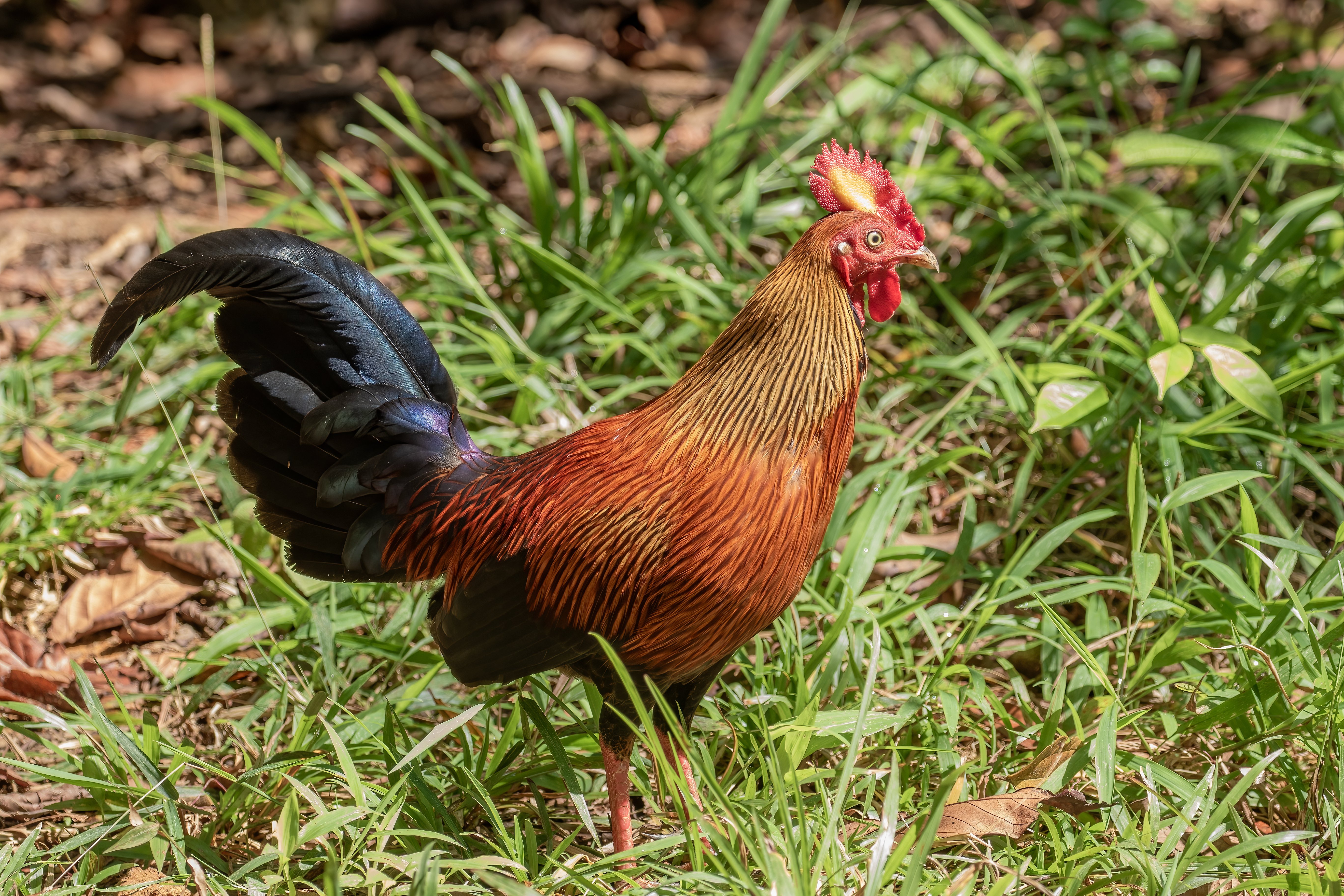
Days 1-2
FLY TO COLOMBO, TRANSFER TO SIGIRIYA
Our tour begins with a scheduled flight to Colombo, the Sri Lankan capital, where we arrive in the afternoon of the following day. Upon arrival, we will be met by Limosa's expert guide Mukesh Hirdaramani and we will then drive to Sigiriya where we will spend two nights.
As we travel to Sigiriya, we will have plenty of opportunities to see many species which live in the paddy fields, streams and coconut plantations. Woolly-necked Storks, along with Great, Medium (part of the recent taxonomic change after the splitting of Intermediate Egret into three species) and Little Egrets can all be found in the green paddy fields, along with Indian Pond Herons, Red-wattled Lapwings, White-throated Kingfishers and the occasional Black-winged Stilt. We are almost certain to see Indian Palm Squirrel, whilst Torque Macaques will be either on the electric power lines or near roadside shops fighting for anything they can grab.
We should reach our hotel in Sigiriya with enough light to see the famous Lion Rock Fortress and the Pidurangala Rock Temple from the lobby.
Sigiriya presents Sri Lankan cuisine in its most authentic manner, and the spread of local curry dishes and rice along with the famous curd and treacle dessert will be an excellent introduction to Sri Lankan cuisine, although for those who wish a variety of western cuisines are also available in most of the hotels on this tour. Two nights at Ehalagala Lake Resort, Sigiriya
Day 3
SIGIRIYA SANCTUARY, MINNERIYA NATIONAL PARK
We start the day with an optional pre-breakfast birding walk around the hotel gardens with an excellent chance of a number of endemic birds. Sri Lanka Woodshrike, Sri Lanka Green Pigeon, Sri Lanka Grey Hornbill, Sri Lanka Junglefowl, Crimson-fronted Barbet and Red-backed Flameback will be our main targets. A pair of Brown Fish Owl often frequent the area and we hope to see them at their day time roost.
Crested Serpent-Eagle and Crested Honey Buzzard are the regular raptors circling the skies above and the chances for rarer possibilities such as the Rufous-bellied Eagle.
After breakfast, we plan to make the short drive to the Sigiriya Sanctuary which surrounds the famous Sigiriya Lion Rock Fortress and will explore the area on foot. The endemic Purple-faced Leaf Monkey and Toque Macaque are two of the primates we hope to find, along with Tufted Grey Langur, and Grizzled Giant Squirrel is another possibility.
Noisy Alexandrine Parakeets are often present in large flocks in the canopy whilst the highly territorial White-rumped Shama and Brown-capped Babbler move along the lower branches of the forest. We stand a good chance of also seeing Black-capped Bulbul, Malabar Pied Hornbill, Tickell’s Blue Flycatcher, Grey-headed Fish Eagle, Small Minivet and Stork-billed Kingfisher.
In the afternoon, we intend to visit either Minneriya or Kaudulla National Park depending on the movement of the elephant herds. During the hotter periods, hundreds of Asian Elephants can be found in Minneriya National Park and this event is known as the “gathering”. The Minneriya tank (reservoir) was built during the 3rd century AD by King Mahasen and this provides water and sustenance for both the human population and animals alike.
Spot-billed Pelican, Lesser Adjutant and Painted Stork are some of the large birds we should come across here, along with flocks of Little Cormorants and Lesser Whistling Ducks which are often seen in flight over the waters. Chital, Golden Jackal, Indian Hare, Wild Boar and Water Buffalo are resident in this park, however, we would be very lucky to find the main predator, the Sri Lanka Leopard.
Later in the evening, there will be an optional night drive for the more elusive mammals of the island and Sigiriya is one of the best places to see Grey Slender Loris, Northern Palm Civet, White-spotted Chevrotain, Small Indian Civet and Indian Gerbil. We have a decent chance of also finding both Fishing Cat and Jungle Cat in the many rice fields and the rare and elusive Rusty-spotted Cat is another possibility. On the bird front, we will hope to see Indian and Jerdon’s Nightjars, along with Brown Fish Owl, Indian Scops Owl with the possibility of also locating Oriental Scops Owl and Forest Eagle Owl.
Day 4
KANDY, UDAWATTAKELE FOREST
After breakfast, we will set off for Kandy and plan to make stops along the way with chances for species such as Black Eagle, White-bellied Sea Eagle and Brahminy Kite. As the elevation and vegetation changes, so will the birds and White-browed Bulbul, Indian Paradise Flycatcher (hopefully with its gorgeous streaming tail), Asian Koel, Sri Lanka Swallow, Yellow-billed Babbler, Red-vented Bulbul and Green Imperial Pigeon are just some of the birds we could see.
After lunch, we plan to visit the Udawattakele Sanctuary which was a pleasure garden for the royal family during the Kandyan Kingdom with no access for commoners. Today, however, no such restrictions exist and the forest is home to many endemic birds such as Layard’s Parakeet, Sri Lanka Hanging Parrot, Brown-capped Babbler, Yellow-fronted Barbet, Crimson-fronted Barbet and Crimson-backed Flameback. Golden-fronted Leafbird, Orange Minivet, Yellow-browed Bulbul, Common Hawk-Cuckoo, Bar-winged Flycatcher-shrike, Large-billed Leaf Warbler, Green Warbler and both white and rufous phases of Indian Paradise Flycatcher are also amongst the long list of possibilities.
Another bird which can be found here is the Black-backed (Oriental) Dwarf Kingfisher and we will actively search for this gorgeous species around the small pond near the entrance to this site. Brown Fish Owl and Forest Eagle Owl can also be found and we are likely to encounter fierce-looking Water Monitors which could be swimming in the pond or basking on dead branches. Juveniles are often skittish to sudden movements but adults frequently stand their ground hissing and ready to lash their tails at any threat. We will keep a watchful eye out for the Sri Lanka Kangaroo Lizard and Sri Lanka Hump-nosed Lizard, along with Green Pit Viper and Green Vine Snake.
Later in the day, we will take a walk in the hotel gardens in search of Brown Wood Owl. These grounds are also home to Giant Flying Squirrel, Golden Palm Civet, Northern Palm Civet, Yellow-spotted Chevrotain, Indian Red Muntjac and Indian Crested Porcupine. Night at Tree of Life Nature Resort, Kandy
Days 5-6
NUWARA ELIYA, HAKGALA BOTANICAL GARDENS, VICTORIA PARK, HORTON PLAINS NATIONAL PARK
An optional pre-breakfast bird walk around the gardens will be an opportunity to look for any species which have eluded us and we then concentrate on finding Sri Lanka Wood Pigeon and Southern Hill Myna with the possibility of Brown-backed Needletail soaring high above.
Leaving Kandy, we will make a visit to a working tea factory where there will be the opportunity to learn about tea manufacturing and taste the various teas produced in the area, which are considered by some to be the best in the world! Another reason to stop here, however, is to look for Hill Swallows which are likely to be seen flying around the tea plantations, whilst we could find a selection of raptors in the the skies above including Booted Eagle.
We intend to arrive in Nuwara Eliya in time for a late lunch at the hotel where we stay for two nights. Located at a ‘cool’ elevation of 1,800 metres, this famous hill-station is the hub of Sri Lanka’s tea estates, and we may welcome the more ‘English’ climate!
After lunch, we will visit the Hakgala Botanical Gardens where we hope to find Yellow-eared Bulbul, Dull-blue Flycatcher, Sri Lanka White-eye, Sri Lanka Scimitar Babbler, Grey-headed Canary Flycatcher, Square-tailed Bulbul, Cinerous Tit and Scaly-breasted Munia, along with Chestnut-backed Owlet and the colourful and endemic Sri Lanka Blue Magpie.
The highland races of Purple-faced Leaf Monkey, which is known locally as the “Bear Monkey” and Toque Macaque are invariably present as they take on the vigilant gardeners that keep watch over the neatly arranged flower beds scattered across the garden.
The following morning, we will take a picnic breakfast as we plan to make an early morning visit to the Horton Plains National Park. Located at an elevation between 2,100-2,300 metres, this is the highest national park in Sri Lanka and encompasses montane grasslands and cloud forest.
One of the main reasons for our early departure for the park is to maximise our chances of seeing the elusive Sri Lanka Whistling Thrush which can often be found at the crack of dawn. We will listen for its high call as the mist gradually lifts from the plains in the hope of locating this endangered bird.
The near threatened Sri Lanka Bush Warbler is another target species we will focus on with Alpine Swift, Pied Bushchat, Mountain Hawk Eagle, Black-winged Kite, Paddyfield Pipit, Eastern Yellow Wagtail, Pale-billed Flowerpecker, Tricoloured Munia, Indian Jungle Crow, Indian Blackbird and Velvet-fronted Nuthatch being on a long list of other possibilities.
There are also a good selection of mammals in the park with Samba Deer, Indian Hare, Wild Boar, Grizzled Giant Squirrel, Dusky-striped Squirrel and both Brown and Stripe-necked Mongooses, however, we will count ourselves very fortunate if we see the country's top predator, the Sri Lanka Leopard.
We will conclude our day with a late afternoon visit to Victoria Park, where new species could include Kashmir Flycatcher, Pied Thrush, Indian Blue Robin and Indian Pitta. Two nights at Heaven Seven, Nuwara Eliya
Day 7
SURREY ESTATE, TISSAMAHARAMA AND KATARAGAMA
After breakfast, we will set off for Kataragama and although this is a moderately long journey (about four hours driving), we break this up with various stops at a number of birding hot spots and by having lunch in the picturesque town of Ella.
Our first stop is likely to be at the Surrey Estate sanctuary if we did not find Brown Wood Owl in Kandy as this is often a reliable site for this species. The sanctuary is a haven for many birds and we will see what we can find before continuing on towards Ella. As we travel, we will need to keep an eye out for Chestnut-headed Bee-eaters that often perch on the electric wires and Crested Serpent Eagles which are constantly looking for the slightest movement in the grass and the chance of a meal.
Our lunch stop will be overlooking a valley and we should enjoy nice views of Layard’s Parakeet, Black-capped Bulbul, Crimson-fronted Barbet, Yellow-browed Bulbul, Brown-headed Barbet and Scaly-breasted Munia.
Later in the afternoon, we will reach the village of Tissamaharama where our focus will be on several owl roosts, with the opportunity to potentially see Indian Scops Owl, Brown Fish Owl, Brown Hawk Owl and Jungle Owlet. There is also a good chance of finding the gorgeous White-naped Woodpecker here.
We plan to stay in Sella Kataragama and will enjoy a scrumptious meal before retiring for the night. Two nights at Grand Tamarind Lake Resort, Sella Kataragama
Day 8
KATARAGAMA AND LUNUGAMWEHERA NATIONAL PARK
Lunugamwehera National Park is situated just 30 minutes from our hotel, and we will take a picnic breakfast and lunch as we plan to have a full day safari in and around this important reserve. Although smaller than the main Yala National Park, Lunugamwehera has a good population of Leopards which has increased in the last few years.
The Weheragala reservoir in the centre of the park is an important area for birds and those we hope to find include Greater Thick-knee, Little Cormorant, Red-wattled Lapwing and both Blue-faced and Sirkeer Malkohas. Brown Shrike, as well as Purple, Loten’s and Purple-rumped Sunbirds should be plentiful and we also often see both Marshall’s and Common Ioras, as well as Yellow-crowned and Brown-capped Pygmy Woodpeckers.
The appropriately named Orange-breasted Green Pigeon is also possible along with Indian Swiftlet, Common Palm Swift, Crested Treeswift, Pied Kingfisher, Yellow-wattled Lapwing.
A small population of Sloth Bears live in the park and usually are seen either in the mornings or at dusk so we will hope to be lucky, although we have a higher chance of observing Samba Deer, Chital, Wild Boar, Water Buffalo, Grey Langur, Toque Macaque, Ruddy and Stripe-necked Mongooses.
Day 9
BUNDALA NATIONAL PARK, SINHARAJA
We plan to check out from our hotel and taking a picnic breakfast with us will proceed to Bundala National Park for a morning safari. During our one-hour drive to the reserve, we will have opportunities to look for Grey-headed Swamphen, Clamorous Reed Warbler, Eurasian Spoonbill and Glossy Ibis in the many fields and waterways.
The dry thorny shrub forest supports many forest birds such as Grey-bellied Cuckoo, Jerdon’s Bushlark, Barred Buttonquail, Tawny-bellied and Yellow-eyed Babblers, as well as Jungle, Plain, Ashy and Grey-breasted Prinias.
Bundala is also an important wintering ground for waders and other water-related species and we will explore the small lagoons and salt pans looking for Marsh Sandpiper, Tibetan Sand Plover, Indian Thick-knee, Brown-headed Gull and both Lesser and Great Crested Terns. Other, more familiar, shorebirds we could see include Common Redshank, Common Greenshank, Black-tailed Godwit, Red-necked Phalarope, Little Ringed Plover, Kentish Plover, Ruff and Little Stint.
After lunch in a suitable restaurant, we will head off to Sinharaja. Three nights at Blue Magpie Lodge, Weddagala
Days 10-11
SINHARAJA RAINFOREST
Birding in the vicinity of our hotel should produce more endemics with our main targets being Legge’s Flowerpecker and the diminutive Crimson-fronted Barbet. Other species we will look out for include Loten’s Sunbird, White-browed Bulbul and Rufous-bellied Eagle.
On both mornings, we will make an early start and head to Sinharaja which is one of the best remaining forests on the island. It is home to more than half of Sri Lanka’s endemic species of mammals and butterflies and all but one of the endemic birds!
As the first rays of sunlight start to filter through the verdant canopy, one of the species we will hope to find is the colourful Sri Lanka Junglefowl foraging on the tangled forest floor, however, another high priority is the Serendib Scops Owl which was only discovered in 2001 and we hope to be able to see this endangered and poorly known bird at a day roost.
On one of our mornings at Sinharaja, we will walk slowly along a wide trail looking for feeding flocks. We may spot Orange-billed Babblers and Ashy-headed Laughingthrushes foraging low to the ground, whilst high in the canopy there could be colourful Red-faced Malkohas and Sri Lanka Scimitar-Babblers.
Scanning the treetops might produce a perched Green Imperial Pigeon or White-faced Starling, whilst Changeable Hawk-Eagle and Oriental Honey Buzzard can be seen above the forest. If we are extremely fortunate, we might encounter the elusive Sri Lanka Thrush which is perhaps the hardest of all the endemics to find.
We should reach an open area where we can enjoy our picnic, whilst keeping a close eye out for the stunning Sri Lanka Blue Magpie and Malabar Trogon.
After lunch, the bird activity is likely to have quietened down but there should still be plenty of butterflies to entertain us including Sri Lankan Tree-Nymph, Blue Glassy Tiger, Cruiser, Common Bluebottle and Sri Lankan Rose.
On another morning, we will look for two more endemics, Sri Lanka Spurfowl and Green-billed Coucal, as well as Southern Hill Myna which also occurs in SW India. We also hope to see roosting Sri Lanka Frogmouths, the endemic Dusky-striped Squirrel and Sri Lankan Birdwing, Sri Lanka's largest endemic butterfly.
Day 12
SINHARAJA RAINFOREST, KATUNAYAKE
We will have a final morning to look for any species that we may not have seen or want better views of and after lunch at our lodge, we will proceed to a hotel near the Airport where a late evening stroll in the gardens can be fruitful for Indian Scops Owl and Brown Hawk Owl. Night at Airport Garden Hotel, Katunayake
Day 13
TRANSFER TO COLOMBO AIRPORT, FLIGHT TO UK
After breakfast, we make the short journey to the international airport for our flight home to the UK, where the tour concludes.
CETACEAN EXTENSION: 10-13 December 2025
Day 12
SINHARAJA RAINFOREST, KOGGALA
We will have a final morning to look for any species that we may not have seen or want better views of and after lunch at our lodge, we will drive to Koggala for the beginning of the extension. Two nights at Koggala Beach Hotel, Koggala
Day 13-14
MIRISSA, KIRALA KELE, KATUNAYAKE
Taking a picnic breakfast, we will head to Mirissa harbour for our first whale-watching excursion which is likely to last between three to five hours depending on the location of the whales.
Over the last decade, it has been increasingly appreciated that the waters off the southern coast of Sri Lanka are a hotspot for many types of cetaceans. Whilst Bryde’s Whales is generally the commonest of the large whales, a range of other species occur including the largest animal to have ever existed on Earth, the mighty Blue Whale.
Whilst the number of Blue Whales fluctuates during the main season, we hope to spot some as we move further into deeper waters. Other cetaceans we could find include Fin, Minke and Sperm Whales and we may see Spinner Dolphins bowriding fishing boats.
A range of seabirds are also possible including Whiskered, Gull-billed, Great Crested and Lesser Crested Terns whilst there will be good chances for Pomarine Skua, Brown Noddy and Little Tern.
Green and Olive Ridley Turtles are the commonest species seen during these trips and we may get lucky and stumble upon a mating pair.
On the afternoon after our first pelagic trip, we plan to visit the Kirala Kele Sanctuary where we stand a good chance of both Yellow and Black Bitterns, as well as Watercock, Grey-headed Swamphen and Painted Stork. Sri Lanka Swallows and Chestnut-headed Bee-eaters may be flying overhead and we could find something rarer such as Cotton Pygmy Goose.
On our second morning, we will go on another whale-watching trip and after lunch will set off to a hotel near Katunayake for our final night in Sri Lanka. A late evening stroll in the hotel gardens can be fruitful for Indian Scops Owl and Brown Hawk Owl. Night at Airport Garden Hotel, Katunayake
Day 15
TRANSFER TO COLOMBO AIRPORT, FLIGHT TO UK
After breakfast, we make the short journey to the international airport for our flight home to the UK, where the tour concludes.
The extension in 2025 costs £795 per person (twin sharing) with a single supplement of £195.
This includes:
- Limosa Tour Leader
- Two nights at a comfortable hotel in Koggala and one night at Katunayake
- Transport including two whale-watching trips
- All main meals with drinking water provided during the day
- All entry fees and taxes
Not included: insurance, drinks and other items of a personal nature.
WHAT TO EXPECT
This is primarily a birding tour but we usually encounter a good variety of mammals with chances for species such as Asian Elephant, Fishing Cat and Leopard. This is also a great trip to see some of Sri Lanka's exotic butterflies and dragonflies, with their wonderful English names!
In common with all birdwatching and wildlife tours to the tropics, you should be prepared for early starts to get the best from key areas before the day heats up and bird activity starts to wane.
BIRDS 200-240 species
MAMMALS 15-20 species
BUTTERFLIES 30-50 species
Sri Lanka has a tropical climate. The uplands are cooler and more temperate, whilst the coastal areas are cooled by sea breezes.
The maximum temperature is likely to be about 30C (86F) and the minimum about 4C (39F) in the hills. It will probably rain at some stage during your stay. The humidity will be around 70% but may be higher at times.
ACCOMMODATION
We use a mix of comfortable tourist hotels and lodges. Some of the accommodation is relatively simple, however, all rooms have private facilities.
MEALS
All main meals are included in the tour price (and with drinking water also provided) commencing with dinner in Sri Lanka on Day 2 and concluding with breakfast at our hotel on Day 13. Food is good to excellent featuring delicious Sri Lankan cuisine. Western food is available at most but not all of the hotels. As noted in the itinerary, some breakfasts and lunches will be picnics whilst others will be taken at the hotels as will all dinners.
WALKING
Mostly easy, although the tropical heat can be tiring and the going more moderate at times along forest trails in the hills.
There will be opportunities to try for nightjars and owls on some evenings so bring a torch if you plan to join these optional excursions.
Sturdy waterproof walking shoes or boots, with stout soles and good grip is recommended.
CLOTHING
Sri Lanka is renowned for its sunshine and it is likely that the weather at this time of year will be hot. Light clothing, should be worn during the day and long sleeved shirts are useful for warding off sunburn. It may, however, be cold first thing in the morning and at altitude and it is likely we will encounter some rain times, so it is essential that you bring a fleece or thick sweater, your waterproofs, a warm hat and gloves.
A small umbrella is useful for when it is wet but warm.
We ask that you wear dull-coloured clothes so that the birds and wildlife are not scared away!
Shoes for use in the field should be stout and hardwearing, as there may be some scrambling over uneven surfaces.
A wide-brimmed sun hat is essential on many days and use of an effective barrier cream and sunglasses is advised.
GROUND TRANSPORT
By minicoach or minibus (appropriate to group size) switching to 4WD vehicles in some of the National Parks. The jeep ride from our Weddagala hotel to reach the park entrance at Sinharaja Forest is along a very bumpy track, so you might like to bring a cushion with you!
PHOTOGRAPHY
Good to excellent photographic opportunities for birds, mammals, butterflies, dragonflies and scenery, especially in more open country, but more difficult in forested areas due to low light levels.
Tour Gallery
View a gallery of images for this tour below, click on an image to view as full size with caption
